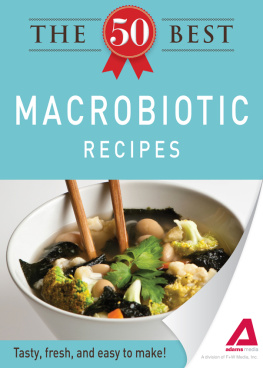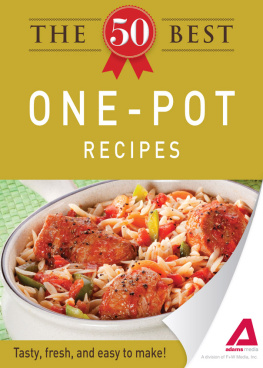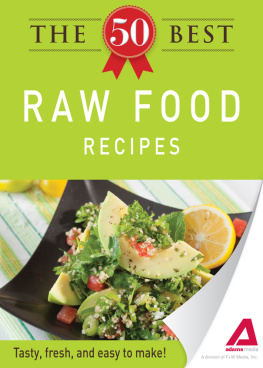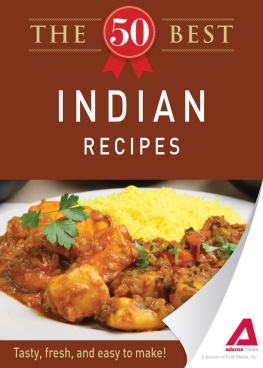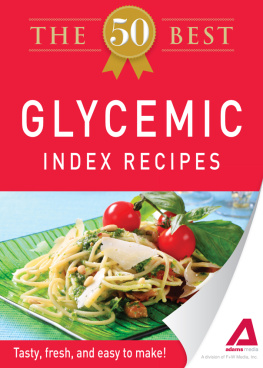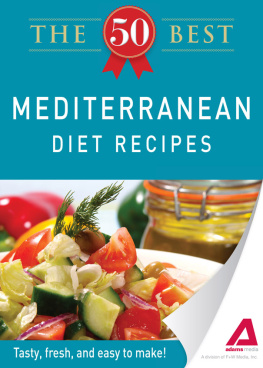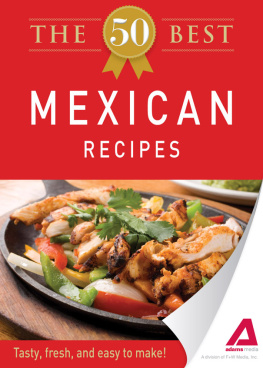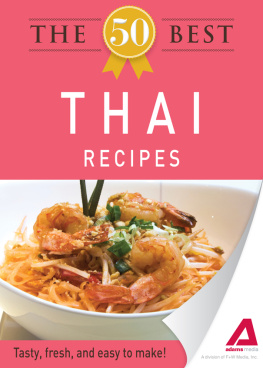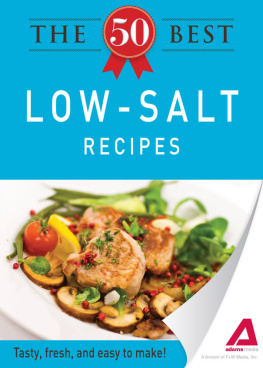
The 50 Best
Macrobiotic Recipes
Tasty, fresh, and easy to make!
Adams Media, a division of F+W Media, Inc.

Avon, Massachusetts
Contents
Introduction
Macrobiotics is a way of living in harmony with the present moment with your present health condition, your present lifestyle, and your present needs and desires. When your health and lifestyle change, you evolve and adjust along with your flexible needs and desires. Macrobiotics is an ancient art of living that is rooted in a profound understanding of the laws and patterns of nature, as applied to the human body. This understanding sees the human body as an integral part of the natural world.
Through food, you connect with your spiritual nature and open yourself up to natural healing. Macrobiotics is about living in harmony with nature and trusting your intuition. This Zen perspective incorporates seasonal, locally grown, and energetically balanced foods into your life. The word macrobiotics literally means large life (macro means large or great and bio means life).
Along with a macrobiotic diet, adjustments in ways of living can make a difference in balancing health on all levels. Nothing is excluded from the macrobiotic diet. Even extreme foods, if balanced, can be healing. More specifically, it is about choosing foods that support and harmonize your dynamic changing health condition. Adjusting your cooking according to the seasons provides the foundational blueprint (or recipe) for living a long life from a more insightful perspective.
Vibrant, energetically balanced food nourishes body, mind, and spirit; it balances emotions and contributes to overall health and well being. Macrobiotics can help you develop this connection with food, an intimate relationship that enhances your intuition and brings you to the present moment. Weve gathered these fifty recipes to help you on your journey to living in your own perfect harmony enjoy!
Sweet Potato and Squash Dumplings
Lime and sweet potato may sound like an odd pairing, but in fact are a sublime combination. This healing snack provides a taste of sweetness without spiking blood sugar.
Serves 2

Ingredients
1 pounds sweet potatoes, peeled
1 pounds butternut squash, peeled
1 cups water
Sweet white miso, to taste
Lime juice, to taste
50 round dumpling wrappers
cup safflower oil
Chop sweet potatoes and squash into small cubes. Place sweet potatoes, squash, and water in a saucepan, and bring to a boil. Steam until vegetables are soft, about 1520 minutes. Mash vegetables thoroughly with a masher or pass them through a food mill into a large bowl. Season to taste with sweet white miso and lime juice.
Place stack of wrappers on a plate and cover with a damp cloth to prevent them from drying out. Place a wrapper in the palm of one hand. Add 1 teaspoon of filling in center of wrapper. With a fingertip, dab one half of wrapper with a little water. Fold over other edge of wrapper and seal sides closed. Make 3 or 4 pleats along sealed edge. Place dumpling in a bowl and cover with a damp cloth. Repeat until filling is used up.
To cook dumplings, heat oil in a skillet. Pan fry dumplings until browned on each side, about 5 minutes.
| Per Serving |
|---|
| Calories: 94 | Fat: 2g |
| Sodium: 84mg | Carbohydrate: 17g |
| Fiber: 2g | Protein: 1g |
What Chew Talking About?
Proper chewing is as important to a meal as cooking. Chewing stimulates digestive enzymes, which alkalize acidic foods, like brown rice. Put your chopsticks or fork down between bites. As you chew, take five in-breaths and five out-breaths. This ensures that you chew ideally between 50100 times for each bite.
Cuke, Avocado, and Carrot Sushi
If youve ever wondered how to make sushi, heres a step-by-step explanation. Youll need a bamboo mat for rolling your vegetable sushi, which makes a great snack for travel.
Serves 6

Ingredients
1 cup short grain brown rice
2 cups spring water
teaspoon sea salt, divided
2 tablespoons sweet brown rice vinegar
2 whole cucumbers, cut into matchsticks
1 large carrot, cut into matchsticks
6 sheets nori
2 whole avocados, sliced
1 tablespoon wasabi powder
Shoyu, to taste
Soak rice in water overnight in saucepan. Add teaspoon salt. Bring to boil, lower heat, and simmer, covered, 4550 minutes. Stir sweet brown rice vinegar into warm cooked rice. Allow rice to cool by spreading it out on sheet pan.
Sprinkle teaspoon salt over cucumber to release water. Blanch carrots.
Place one sheet of nori shiny side down on the bamboo mat. Dampen hands with water. Pat a thin layer of rice onto nori, about " thick, leaving " plain nori border around the four edges. Place cucumber, carrot, and avocado together at the near edge.
Carefully and firmly roll up mat, dabbing the final edge of nori with a bit of water to seal. Place seam-side down. With a dampened bread knife, slice each roll into 6 segments. Clean off knife as you slice.
Serve with wasabi and shoyu. In a small saucepan, heat shoyu and a little water for 23 minutes. To prepare wasabi, mix 2 tablespoons wasabi powder with enough water to create a paste.
| Per Serving (without shoyu) |
|---|
| Calories: 251 | Fat: 11g |
| Sodium: 73mg | Carbohydrate: 36g |
| Fiber: 8g | Protein: 6g |
Goodness Gracious, Great Balls of Rice
The rice ball is an energetically balanced food that is perfect for travel. A quarter of salted umeboshi plum is inserted into a ball of cooked brown rice, which is wrapped with antibacterial nori. Preserved in the center and protected on the periphery, a rice ball can be stored 3 days unrefrigerated.
Homemade Hummus
The flavors used in macrobiotic cooking are meant to balanced between sweet, salty, sour, bitter, and pungent. The kombu and umeboshi paste provide the salty flavors in this recipe; no table salt required.
Serves 6

Ingredients
1 cup garbanzo beans, soaked
3 cups spring water
1 stamp-sized piece kombu
2 cloves garlic, crushed
3 medium scallions, finely chopped
2 tablespoons parsley, minced
2 teaspoons umeboshi paste
4 tablespoons lemon juice
1 tablespoon white miso
1 tablespoon olive oil
Drain beans. Place garbanzo beans and water in a pressure cooker. Bring to boil on a medium flame. Skim off foam. Add kombu. Cover, bring to pressure, lower heat, and pressure cook for 1 to 1 hours. Remove lid and allow beans to come to room temperature.
Strain out cooking liquid and set liquid aside. Pure garbanzo beans with a little cooking liquid. Add garlic, scallions, parsley, umeboshi paste, lemon juice, miso, and olive oil and pure, gradually adding a little cooking water to reach desired consistency. Add more umeboshi paste to taste if desired.
| Per Serving |
|---|
| Calories: 156 | Fat: 4g |
| Sodium: 248mg | Carbohydrate: 23g |
Next page
